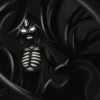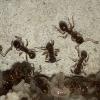- Formiculture.com
- Forums
- Gallery
- Members
- Member Map
- Chat

Monomorium Minimum
Started By
AntEnthused
, Sep 22 2019 8:10 PM
11 replies to this topic
#1
 Offline
-
Posted September 22 2019 - 8:10 PM
Offline
-
Posted September 22 2019 - 8:10 PM
I have tiny black ants IN my kitchen wall. Almost positive it's monomorium minimum from my research on Google lol.
What are the odds of a queen wondering out of the wall, if I was to make a habit of food and water (feeding grounds of sorts) next to where they come out of the wall?
What are the odds of a queen wondering out of the wall, if I was to make a habit of food and water (feeding grounds of sorts) next to where they come out of the wall?
#2
 Offline
-
Posted September 22 2019 - 8:21 PM
Offline
-
Posted September 22 2019 - 8:21 PM
Most ants including M. minimum don't really let the queen out of their nest frequently. The workers will take food into the nest for her instead of making the queen find it herself. The only time you might see the queen outside of her nest is if the colony tries to relocate.
#3
 Offline
-
Posted September 23 2019 - 1:14 AM
Offline
-
Posted September 23 2019 - 1:14 AM
as said, the queen will not under any circumstances leave the nest except in the rare circumstance that the colony decides to move. if you plan on capturing her, i would also advice against that, as at this stage she likely needs her workers and will not do well without them. i am unsure if she would even be able to start a new colony if you captured some workers with her. it is hard to say.
i am assuming a lot, but if you want to own this species of ant i would highly suggest you attempt to find out when their nuptial flight is. either by researching it or watching for if any winged ants begin leaving the nest.
#4
 Offline
-
Posted September 23 2019 - 1:21 AM
Offline
-
Posted September 23 2019 - 1:21 AM
as said, the queen will not under any circumstances leave the nest except in the rare circumstance that the colony decides to move. if you plan on capturing her, i would also advice against that, as at this stage she likely needs her workers and will not do well without them. i am unsure if she would even be able to start a new colony if you captured some workers with her. it is hard to say.
i am assuming a lot, but if you want to own this species of ant i would highly suggest you attempt to find out when their nuptial flight is. either by researching it or watching for if any winged ants begin leaving the nest.
#5
 Offline
-
Posted September 23 2019 - 1:24 AM
Offline
-
Posted September 23 2019 - 1:24 AM
The colony is inside my kitchen wall. I was wondering if I could get them to move to a container. You know get the queen to move.
Most ants including M. minimum don't really let the queen out of their nest frequently. The workers will take food into the nest for her instead of making the queen find it herself. The only time you might see the queen outside of her nest is if the colony tries to relocate.
#6
 Offline
-
Posted September 23 2019 - 6:16 AM
Offline
-
Posted September 23 2019 - 6:16 AM
I'm really not sure of any way to get her out of there that doesn't involve breaking the wall. As long as it's protected and humid, the ants have no reason to leave.
#7
 Offline
-
Posted September 23 2019 - 9:50 AM
Offline
-
Posted September 23 2019 - 9:50 AM
Since they are in your wall I'm gonna guess that they are actually tapinoma sessile, a common house infesting ant.
- ANTdrew likes this
My journals:
Polyergus Mexicanus: https://www.formicul...gs/#entry175528
Lasius minutus: https://www.formicul...cs/#entry174811
Lasius latipes: https://www.formicul...gs/#entry206449
General acanthomyops journal: https://www.formicul...yops-with-eggs/
Polyergus Mexicanus: https://www.formicul...gs/#entry175528
Lasius minutus: https://www.formicul...cs/#entry174811
Lasius latipes: https://www.formicul...gs/#entry206449
General acanthomyops journal: https://www.formicul...yops-with-eggs/
#8
 Offline
-
Posted September 23 2019 - 2:22 PM
Offline
-
Posted September 23 2019 - 2:22 PM
do the workers have pointed abdomens, and do they have two petiole nodes?
#9
 Offline
-
Posted September 23 2019 - 2:28 PM
Offline
-
Posted September 23 2019 - 2:28 PM
Neither of these species are good to keep. I would instead suggest Lasius, Tetramorium, Formica, or Pogonomyrmex occidentalis.
- Guy_Fieri likes this
Currently keeping:
Tetramorium immigrans, Pogonomyrmex occidentalis
Myrmica punctiventris, Formica subsericea
Formica pallidefulva, Aphaeogaster cf. rudis
Camponotus pennsylvanicus
Camponotus nearcticus
Crematogaster cerasi
Temnothorax ambiguus
Prenolepis imparis
#10
 Offline
-
Posted September 28 2019 - 8:07 PM
Offline
-
Posted September 28 2019 - 8:07 PM
do the workers have pointed abdomens, and do they have two petiole nodes?
#11
 Offline
-
Posted September 28 2019 - 8:09 PM
Offline
-
Posted September 28 2019 - 8:09 PM
do the workers have pointed abdomens, and do they have two petiole nodes?
One point. Pm me your email and I can sent you a picture if you want.
#12
 Offline
-
Posted September 29 2019 - 9:48 AM
Offline
-
Posted September 29 2019 - 9:48 AM
do the workers have pointed abdomens, and do they have two petiole nodes?
One point. Pm me your email and I can sent you a picture if you want.
Just DM me. Upload the pic to the gallery then copy and paste it.
0 user(s) are reading this topic
0 members, 0 guests, 0 anonymous users

















